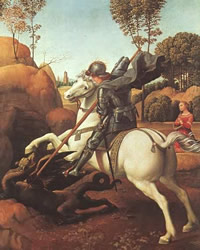 |
St
George and the dragon Raphael, c.1505-1506 |
Although he is the patron saint of England and one of the most famous figures in Christianity, there is very little that is known for certain about St George. The historian Eusebius of Caesarea, writing around 322, mentions an unnamed soldier of noble birth who was put to death at Nicodemia on 23 April 303 CE, a day still commemorated as St George’s Day. In the early 8th century a work known as the Acts of St George was translated into Anglo-Saxon. Because of the many miracles attributed to him he became universally recognised as a saint sometime after 900 CE.
Crusaders at the battle of Antioch in 1098 had an experience of his presence, as a result of which he became the patron saint of soldiers. The banner of St George—the red cross of a martyr on a white background—became part of the uniform of English soldiers, possibly during the reign of Richard I; later it became the flag of England and the White Ensign of the Royal Navy.
In 1265 a book known as Readings on the Saints* was published, which popularised the legend of St George and the dragon,** a story subsequently acted out as part of the medieval miracle plays. In 1348 Edward III adopted St George as the patron of his order of chivalry, the Knights of the Garter, and it is believed that it was around this time that he was officially appointed the patron saint of England.
In 1940 during the bombing of Britain by the German Luftwaffe, King George VI instituted the George Cross for acts of heroism and courage.***
**The story of George and the dragon is very similar to—and may actually have been based on—the Greek myth of the hero Perseus, who similarly slayed a monster and rescued a woman in distress. There are many variations to St George’s story, but most agree that the daughter of the king of Libya was being offered as a sacrifice to a dragon that had been ravaging the countryside. Wandering through the desert, George was told of this by a hermit; George then defeated the dragon and rescued the princess, as visualised in the painting by Raphael (above).
***This award—which can be received posthumously—is usually granted to civilians, in contrast to the Victoria Cross, which is the highest military decoration in Britain.